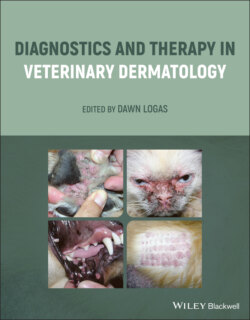Читать книгу Diagnostics and Therapy in Veterinary Dermatology - Группа авторов - Страница 2
Table of Contents
Оглавление1 Cover
2 Title Page
3 Copyright Page
4 Acknowledgments
5 Foreword
6 List of Contributors
7 1 The Skin as an Immune Organ Immune System of the Skin Epidermis Dermis Subcutis Defense from Harmful Substances Dysfunction of the Immune System Recommended Reading
8 2 How to Get the Most Out of Your Dermatologic History and Examination Dermatologic History Dermatologic Examination Recording Results
9 3 New Diagnostic Tools and Tests for Dermatology The Importance of Diagnostic Investigations in Dermatology Molecular Diagnostic Tests: How Do They Work and What Is Available? Serology Primary Binding Tests Secondary Binding Tests Tertiary Binding Tests Polymerase Chain Reaction Pulsed‐Field Gel Electrophoresis Transmission Electron Microscopy Whole‐Genome Sequencing Matrix‐Assisted Laser Desorption Ionization‐Time of Flight Mass Spectrometry Conclusion References
10 4 When, Where, and How to Biopsy Skin When Where How Where to Send Recommended Reading
11 5 Antimicrobial‐Resistant Staphylococcal Infection Staphylococcus spp. Associated with Skin Infections Staphylococcal Antimicrobial Resistance Mechanisms Risk Factors for Acquisition of Methicillin‐Resistant Staphylococci Culture and Antimicrobial Susceptibility Testing Treatment of Antimicrobial‐Resistant Staphylococcal Infections Restriction‐of‐Use Policy Future Directions for Treatment of Antimicrobial‐Resistant Staphylococcal Infections Conclusion Recommended Reading References
12 6 Fungal and Oomycete Infections Dermatophytosis Malassezia Oomycetes Subcutaneous Mycoses References
13 7 Parasitic Infections Canine Scabies Feline Scabies Canine Demodicosis Feline Demodicosis Lice Ticks Fleas Recommended Reading
14 8 Emerging Infectious Diseases in Veterinary Dermatology Canine and Feline Cutaneous Leishmaniasis Sporotrichosis Bartonellosis Recommended Reading References
15 9 Canine Hypersensitivities History Physical Exam Atopic Dermatitis Food “Allergy” Contact Allergy Insect Bite Allergies Recommended Reading References
16 10 Feline Hypersensitivities What Does a Hypersensitive Cat Look Like? Symmetric, Initially Nonlesional Pruritus with Subsequent Trauma and Hypotrichosis or Alopecia Papular Crusting Dermatitis (Miliary Dermatitis) Otitis Eosinophilic Granuloma Complex Diagnostic Workup Diagnosis Cat Still Has Problems: How to Further Narrow Down the Diagnosis Environmental Triggers Controlling Clinical Signs during the Diagnostic Workup Disorders That May Be Confused with Feline Hypersensitivity Diseases Recommended Reading References
17 11 Common and Emerging Autoimmune Diseases Pemphigus Foliaceus Sebaceous Adenitis Sterile Nodular Panniculitis Symmetric Lupoid Onychodystrophy, Symmetric Onychomadesis Proliferative Thrombovascular Necrosis of the Pinnae Cutaneous Vasculitis Erythema Multiforme Ischemic Dermatopathies Recommended Reading References
18 12 Endocrine and Metabolic Diseases with Dermatologic Manifestations Hypothyroidism Feline Hyperthyroidism Canine Hypercortisolism Feline Hypercortisolism Sex Hormone Dermatoses Cutaneous Xanthomas Hepatocutaneous Syndrome Zinc‐Responsive Dermatosis Alopecia X Recommended Reading References
19 13 Medical Management of Acute and Chronic Otitis Acute Otitis Chronic Otitis When to Refer Recommended Reading References
20 14 What Is the Difference between Brand Name, Generic, and Compounded Drugs? Drugs Approved by the US Food and Drug Administration Generic Drugs Compounded Drugs References
21 15 Topical Therapies Anti‐infectious Antipruritics Antiseborrheic Barrier Repair Immunoregulators Application Recommended Reading References
22 16 Antimicrobial Resistance Determinants of Antimicrobial Resistance Determination of Susceptibility or Resistance Mutant Prevention Concentration Antibiotic Classes and Resistance Mechanisms Advances in Laboratory Diagnostics and Their Impact on Antibiotic Resistance Conclusions Recommended Reading References
23 17 Omega‐3 Fatty Acids Recommended Reading References
24 18 Immunopharmacology Drugs That Affect Innate Immunity Drugs That Affect the Bridge between Innate and Adaptive Immunity Drugs That Affect Adaptive Immunity Undefined Mechanisms (Anti‐inflammatory, Regulatory, Other) Recommended Reading
25 19 Allergen Immunotherapy Mode of Action Indications for Allergen Immunotherapy Testing and Selection of Allergens for the Extract Adverse Effects of Allergen Immunotherapy Route of Administration Conclusions Recommended Reading References
26 20 Biologic Therapies for Dermatologic Use Monoclonal Antibodies in Veterinary Dermatology DNA Vaccination Intravenous Immunoglobulin Interferons Staphylococcal Bacterins Conclusions References
27 21 Use of Lasers in Dermatology Diode Lasers CO2 Lasers Laser Safety Considerations for Laser Usage Neoplastic Conditions Ears Infectious Diseases Inflammatory Conditions Recommended Reading
28 22 Unconventional and Plant‐Based Therapies Homeopathy Photobiomodulation Platelet‐Rich Plasma Probiotics Plant‐Based Therapies Topical Therapies References
29 23 Sedation, Anesthesia, and Pain Management in Small Animal Dermatology Sedation Skin Testing General Anesthesia Monitoring Local Anesthesia Topical Local Anesthesia Local Infiltration Ring Block Pain Management Conclusions References
30 24 How Your Nursing Staff Can Improve Efficiency and Compliance in the Management of Dermatologic Cases History Taking Intake Interview Pruritus Scale Diagnostic Testing Patient Discharge Patient Follow‐Up Telephone Calls Conclusions References
31 25 Communication Between the Client, Primary Care Practitioner, and Dermatologist Communication with the Pet Family Initiating the Session Gathering Information Physical Examination Explanation and Planning Closing the Session Collaboration Between Primary Care and Specialist Veterinarians Attitudes and Perceptions of Primary Care Veterinarians Regarding Referral to a Specialist Building a Collaborative Relationship: For Primary Care Veterinarians Building a Collaborative Relationship: For Specialists Inter‐Practice Communication and Skills The Pet Family’s Role in Communication Conclusions Recommended Reading References
32 26 The Future of Technology and Computers in Veterinary Medicine Electronic Medical Records Behavioral and Physiologic Monitoring Current Research and Future Opportunities Off‐Body Technologies for Tracking Activity, Behavior, and Physiologic Changes On‐Body, Wearable Activity, Behavior, and Physiologic Trackers In‐Body Activity, Behavior, and Physiologic Tracking Benefits of Behavioral and Physiologic Tracking Challenges in Behavioral and Physiologic Tracking Conclusions References
33 Index
34 End User License Agreement
